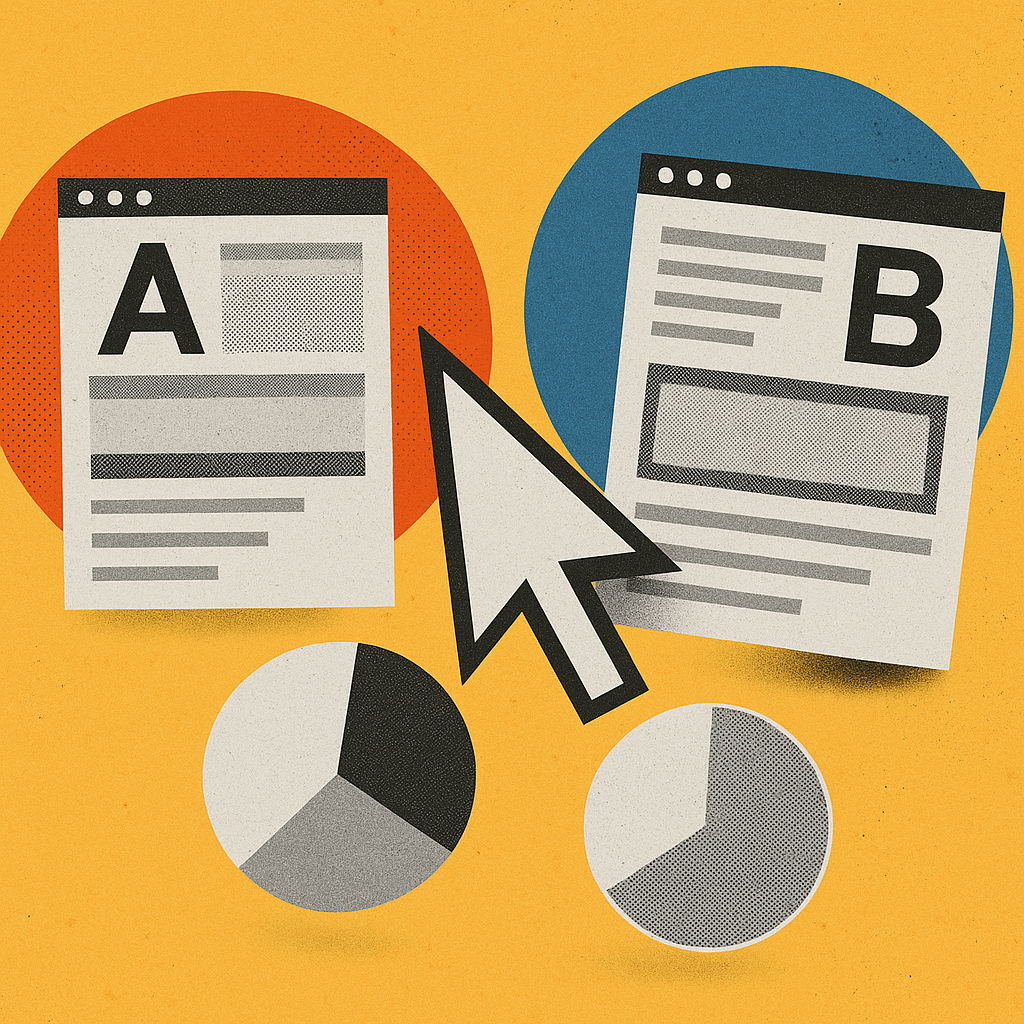What is A/B Testing and How Does It Work?
Understanding A/B Testing
A/B testing, also called split testing, involves running controlled experiments to compare multiple versions of a webpage, app, or marketing asset. The goal: identify which version performs best based on key performance indicators (KPIs). The process divides the audience randomly into groups; each group sees a different variation—A as the control, B as the variant. Then, measure which version yields higher conversion rates, click-through rates, or engagement. For example, a company might test two headlines on a landing page—one with a direct call-to-action (CTA), the other with a subtle prompt—to see which drives more sign-ups.
Why Is A/B Testing Critical for Website Optimization?
The Significance of A/B Testing
A/B testing enables data-driven decisions, reduces risk, and deepens understanding of user behavior. By testing different webpage elements—buttons, headlines, layouts—businesses pinpoint what enhances performance. For instance, Amazon's real-time offer testing moved high-profit items to prominent spots, boosting revenue without guesswork Source: CXL. Netflix's extensive testing personalizes homepage content, improving user experience and retention (VWO). Furthermore, A/B testing minimizes reliance on assumptions, helping avoid costly mistakes. It uncovers audience preferences, such as younger users favoring modern designs, which allows targeted customization. Optimizing sign-up forms, navigation, and content leads to higher satisfaction and loyalty Source: Optimizely. Small changes—like button colors or placements—can compound over time to yield better ROI Source: Kameleoon. Ultimately, adopting A/B testing as a core strategy keeps organizations competitive, continuously learning from user data and maximizing website performance Source: CXL.
How Do I Create an Effective A/B Test?
Step-by-Step Guide
1. Define Clear Goals and Metrics
Start by pinpointing your main objective—boosting conversions, increasing clicks, reducing bounce rate. For example, if testing a landing page, aim to improve form submissions or sales. Clear goals guide your hypothesis and help interpret results Source: HubSpot. Learn more about aligning your marketing efforts in our social media marketing strategy guide.
2. Start with a Hypothesis
Formulate a testable hypothesis based on data or insights. For instance, "Changing the CTA button color from red to green increases clicks by 10%." Make sure your hypothesis is specific and data-driven, serving as the foundation for variations Source: CXL.
3. Create One Variable per Test
Isolate a single element—headline, CTA text, image, or layout—to test. Testing multiple elements simultaneously complicates analysis. For example, test only button color while keeping other factors constant Source: HubSpot. To ensure your tests are effective, check out our social media content calendar guide for planning consistent testing schedules.
4. Design Variations Carefully
Develop a control (current version) and a challenger (modified version) with just the tested element changed. Use visual tools or coding snippets for implementation. For example, create two landing page versions differing only in headline or button color Source: Unbounce.
5. Determine Sample Size and Duration
Calculate the necessary sample size with tools like Evan Miller's calculator to ensure statistical significance. Run tests for at least 1–2 weeks to avoid false positives caused by short-term fluctuations Source: HubSpot. For insights on measuring success, explore our social media KPIs complete guide.
6. Run the Test Simultaneously
Expose both variations to similar audiences at the same time to control external influences like seasonality or traffic shifts. Use A/B testing tools that split traffic randomly and evenly Source: Optimizely.
7. Collect and Analyze Data
After the test period, analyze data focusing on your primary metric. Use significance calculators to verify reliability. Segment data by audience groups—device type, new vs. returning visitors—for deeper insights Source: CXL. To interpret your results effectively, see our social media analytics complete guide.
8. Implement the Winning Variation
Replace the control with the statistically significant winner. Continue monitoring and avoid stopping the test prematurely Source: HubSpot.
9. Iterate and Test Again
Use learnings to formulate new hypotheses. Test different elements—headlines, images, layouts—to optimize continuously Source: Unbounce. For ongoing improvements, check out our social media trend 2025 guide.
10. Avoid Common Mistakes
Ensure you do not test multiple variables at once, stop tests early, or target the wrong audience. Use proper sample sizes, run tests long enough, and interpret data carefully to prevent misleading conclusions Source: CXL.
What Are Common Mistakes to Avoid in A/B Testing?
Typical Pitfalls
Running Tests Prematurely or Calling Winners Too Early
Many stop tests once software indicates 95% confidence, risking false positives if the sample is small or the duration too short. Short tests—just days—may produce results that vanish later when extended, due to external factors like weekly patterns or seasonality. Run tests at least 2–4 weeks, ensuring sufficient sample size (e.g., 350–400 conversions per variation) and confirming significance over a full cycle [Sources: Convert.com, CXL]. For tips on avoiding these issues, see our social media crisis management plan guide.
Not Running Tests Long Enough
Short durations can skew results because of daily or weekly fluctuations. For example, testing only on weekdays may miss weekend effects; during holidays, results may distort. Run tests for at least 7 days, ideally 14–28 days, to capture external influences [Sources: Invesp, CXL].
Ignoring Traffic and Conversion Volumes
Low traffic or conversions delay reaching significance, sometimes taking months. For example, a site with 100 weekly conversions may need over six months to detect a 15% lift. Larger, bold changes may be more practical for low-traffic sites—prioritize high-impact pages and significant modifications [Sources: Invesp, CXL].
Failing to Form a Clear Hypothesis
Random testing wastes time and traffic. Hypothesize based on data; e.g., "Changing CTA color will improve conversions." Clear hypotheses articulate the problem, how you identified it, and your proposed solution [Sources: Invesp, CXL].
Not Segmenting Results
Aggregated data can hide insights. A variation may perform poorly overall but excel on mobile. Without segmentation—by device, source, or user type—you miss these nuances, leading to suboptimal decisions. Post-test analysis should include segmentation [Sources: Adobe, CXL].
Testing Multiple Elements Simultaneously
Changing several elements together makes it impossible to identify which caused the result. Focus on one element unless conducting multivariate testing [Sources: Convert.com, CXL].
Skipping Sample Size Calculation
Running tests without knowing the needed sample size risks inconclusive results. For example, only 100 visitors per variation may miss a 5% lift. Use tools like Convert’s calculator to determine the required number for 95% confidence [Sources: CXL, Adobe].
Adjusting Traffic or Stopping Tests Midway
Changing traffic splits or halting tests early biases results. Always run to completion or until reaching the sample size. Shifting traffic during a test introduces bias; stopping early risks missing the true winner [Sources: Convert.com, CXL].
Ignoring User Feedback or Technical Issues
Broken links, slow load times, or user complaints invalidate results. QA variations across devices beforehand prevents false negatives—ensure a smooth user experience [Sources: Convert.com, CXL].
Failing to Document Tests and Learnings
Without documentation, teams forget why tests ran, leading to repeated mistakes. Maintain logs with hypotheses, results, and insights to improve future testing cycles [Sources: Invesp, CXL].
How Do I Analyze and Interpret A/B Test Results?
Systematic Analysis
Analyzing results requires a structured approach:
1. Compare Results Against KPIs
Focus on metrics aligned with goals—conversions, CTR, revenue, bounce rate, session duration, average order value. For example, test headlines by evaluating which increases conversions or revenue Source: Unbounce. For more insights on tracking success, review our social media ROI guide.
2. Confirm Statistical Significance
Use built-in tools or calculators to verify if differences are unlikely due to chance. A p-value below 0.05 indicates high confidence in the winner Source: Dynamic Yield.
3. Check Sample Size and Duration
Ensure you have enough data—calculate with tools like Unbounce's sample size calculator—and run the test for full business cycles to account for variability [Sources: Unbounce, CXL].
4. Consider External Factors
Account for influences like seasonality, ongoing campaigns, technical issues, or external events. These can skew results if not controlled Sources: Segment.
5. Segment Data for Insights
Break results by segments—device, source, user type—to uncover hidden opportunities. For example, a variation may perform well on mobile but not desktop [Sources: Dynamic Yield].
6. Examine Secondary Metrics
Look beyond primary KPIs. Engagement, session duration, or cart abandonment can reveal unintended effects or opportunities. A variation might boost conversions but reduce session quality, signaling issues.
7. Understand Why Variations Win or Lose
Use qualitative data—heatmaps, session recordings—to interpret user behavior. If a change increases clicks but decreases purchases, explore user flow issues.
8. Decide and Act Based on Data
Implement the winner if statistically significant and aligned with goals. If inconclusive, refine hypotheses or personalize for segments. Document findings and iterate [Sources: Unbounce, Optimonk].
Following these steps and leveraging authoritative insights enables accurate interpretation, deep understanding of user behavior, and strategic, data-driven improvements.




